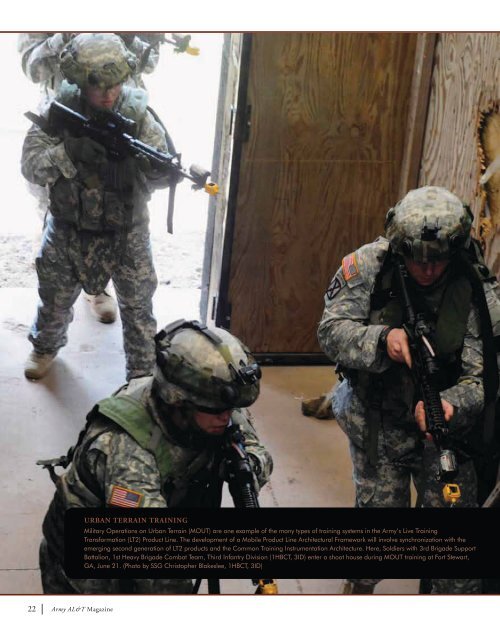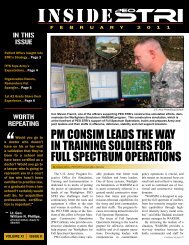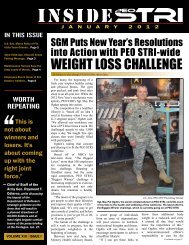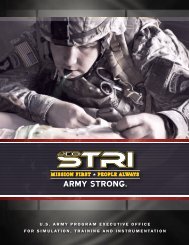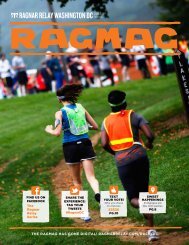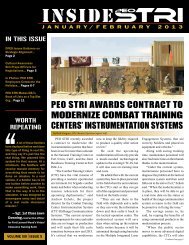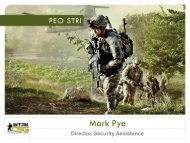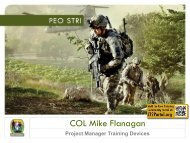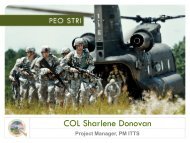Read more! - PEO STRI - U.S. Army
Read more! - PEO STRI - U.S. Army
Read more! - PEO STRI - U.S. Army
Create successful ePaper yourself
Turn your PDF publications into a flip-book with our unique Google optimized e-Paper software.
URBAN TERRAIN TRAINING<br />
<br />
<br />
<br />
<br />
<br />
22 <strong>Army</strong> AL&T Magazine
LIVETRAINING<br />
GoesMOBILE<br />
ACQUISITION<br />
<strong>PEO</strong> <strong>STRI</strong> advances <strong>Army</strong> vision for handheld applications with<br />
common architecture, data, standards, processes, and components<br />
by Andrea Morhack, James Todd, and Dr. Jeremy T. Lanman<br />
In May 2010, the U.S. <strong>Army</strong> Deputy Chief of<br />
Staff, G-3/5/7 stated that the vision for the<br />
Common Operating Environment (COE)<br />
is to establish “an approved set of standards<br />
that enable secure and interoperable applications<br />
to be rapidly developed and executed across a variety<br />
of computing environments.”<br />
This vision includes the mission to “provide Soldiers<br />
with a position of advantage using mobile or<br />
handheld devices to access relevant, trusted information<br />
required to make timely decisions.” To<br />
make this a reality, the <strong>Army</strong> has established a set<br />
<br />
goal, critical to the success of this mission, is the<br />
development of a Mobile Product Line Architectural<br />
Framework (MPLAF).<br />
The <strong>Army</strong> is just beginning to pursue the use of<br />
mobile devices and applications in its live training<br />
domain. The migration to and reliance on these<br />
<br />
few years. As the <strong>Army</strong> looks into the application<br />
of mobile devices for many of its systems, there<br />
is an opportunity to apply product-line architectural<br />
techniques and lessons learned. The<br />
adoption of standards, frameworks, and style<br />
guides will ensure 1) early realization of cost<br />
avoidances; and 2) early return on investment<br />
from systematic reuse.<br />
Currently, live training mobile applications range<br />
from maintenance roles, through command and<br />
control systems, to after-action reviews. These<br />
applications will be operated in stand-alone or<br />
<br />
or consumers deployed into a cloud-based COE<br />
environment, allowing Soldiers on-demand training<br />
capability. However, just as there are many<br />
<br />
including security and information assurance,<br />
technical performance, and the current acquisition<br />
business model. To ensure success, an underlying<br />
mobile architectural framework that promotes<br />
product-line guidance and standardization must<br />
be established and maintained.<br />
ASC.ARMY.MIL 23
LIVE TRAINING GOES MOBILE<br />
HANDHELD TARGET CONTROL<br />
<br />
<br />
<br />
of applying an MPLAF, a set of standards,<br />
and a style guide to live training,<br />
and will describe lessons learned and<br />
implementation considerations for developing<br />
mobile applications. Further<strong>more</strong>,<br />
it will discuss synchronization of the live<br />
training MPLAF with the emerging<br />
second generation of the <strong>Army</strong>’s Live<br />
Training Transformation (LT2) Product<br />
Line and the Common Training Instrumentation<br />
Architecture (CTIA), and the<br />
<br />
Training, and Instrumentation’s (<strong>PEO</strong><br />
<strong>STRI</strong>’s) overall enterprise mobile architecture<br />
approach.<br />
MOBILE PRODUCT<br />
LINE CONCEPT<br />
LT2 has long been a true software product<br />
line. The LT2 Family of Training<br />
Systems is based on the <strong>Army</strong>’s CTIA.<br />
The CTIA is the technical framework<br />
that provides commonality across training<br />
instrumentation systems, and is the<br />
live training instrumentation interface<br />
<br />
Integrated Training Environment, a<br />
common instrumentation platform for<br />
training systems. The CTIA consists of<br />
standards, protocols, infrastructure services,<br />
and common software components<br />
to be used by system developers. It is the<br />
core software infrastructure of training<br />
instrumentation systems.<br />
LT2 core assets include open architectures,<br />
common software components,<br />
standards, processes, policies, governance,<br />
documentation, and <strong>more</strong>, all leading to<br />
a common approach and framework for<br />
developing live training systems. Examples<br />
of the many types of training systems<br />
in the LT2 family include Military<br />
Operations on Urban Terrain, Maneuver<br />
Combat Training Center, instrumented<br />
<br />
training systems.<br />
Similar to the LT2 Product-Line Architectural<br />
Framework, the MPLAF vision<br />
is to create a family of mobile applications<br />
using a common architecture with<br />
common data, standards, processes,<br />
and components. This commonality<br />
facilitates the rapid development of new<br />
applications, and ensures that applications<br />
across the LT2 product line can<br />
communicate and interoperate with one<br />
another. This is important because large<br />
training exercises need to employ different<br />
training systems working together.<br />
The LT2 product line makes use of<br />
plug-and-play components and applications<br />
that are common between<br />
products and applications, allowing<br />
oped<br />
for one application to be applied<br />
24 <strong>Army</strong> AL&T Magazine
to others. This concept provides the<br />
<br />
derive from commonality, standardization,<br />
and interoperability, reducing total<br />
life-cycle costs.<br />
<br />
COE, the MPLAF should include a<br />
common software development infrastructure<br />
(CSDI) comprising operating<br />
and run-time systems, native and common<br />
applications and services, software<br />
development kits, and standards and<br />
technologies for handheld and wearable<br />
devices, with an initial focus on implementation<br />
of live training capabilities.<br />
Additionally, the MPLAF will provide<br />
<br />
support integration of compliant capability<br />
solutions on the Soldier.<br />
As a proof of concept, the Target Modernization<br />
program within <strong>PEO</strong> <strong>STRI</strong>’s<br />
Project Manager Training Devices (PM<br />
TRADE), in conjunction with the U.S.<br />
<strong>Army</strong> Simulation and Training Technology<br />
Center, developed a mobile<br />
device application to support the Targetry<br />
Range Automated Control and<br />
Recording (TRACR) control system.<br />
The TRACR Ültra Lite (TÜL) handheld<br />
target control system, implemented<br />
<br />
<br />
is ready for transition to operational use.<br />
TÜL is the next-generation handheld<br />
target controller for use on the <strong>Army</strong>’s<br />
<br />
a suite of graphical user interface-based<br />
controls for the individual or scenario<br />
control of targets in either operational or<br />
maintenance mode. TÜL communicates<br />
with the tower TRACR computer via a<br />
rest state interface to ensure timeliness of<br />
performance and safety of control.<br />
Based on level of maturity, PM TRADE’s<br />
TÜL currently focuses on adequately<br />
<br />
<br />
common standards and practices for<br />
the MPLAF. Design considerations<br />
for the CSDI and associated hardware<br />
<br />
are preliminary. However, synchronization<br />
with the current LT2 Product Line<br />
construct and next-generation CTIA<br />
Service-Oriented Architecture (SOA),<br />
and systematic reuse has begun, with<br />
similar mobile initiatives in PM TRADE<br />
using MPLAF.<br />
CHALLENGES AND<br />
LESSONS LEARNED<br />
The emergence of mobile technology in<br />
the training environment introduces a<br />
number of challenges, including information<br />
assurance, ruggedization, reusability,<br />
integration into existing training systems,<br />
and life-cycle support.<br />
One of the greatest challenges with the<br />
emergence of mobile architecture is<br />
ensuring the continued protection of<br />
data and adhering to evolving security<br />
regulations. Information assurance<br />
requirements need to keep up with the<br />
pace of mobile innovation. In addition<br />
to threats presented by a standard “nonmobile”<br />
system, mobile devices present<br />
their own unique security challenges.<br />
Because of these constantly evolving<br />
threats, it is imperative that mobile systems<br />
go through the DOD Information<br />
<br />
Process to successfully achieve an Authorization<br />
to Operate. The security risk for<br />
mobile architectures needs to be reduced<br />
to an acceptable level, while allowing<br />
innovation in this area to continue.<br />
Second, mobile devices need to be ruggedized<br />
for use by Soldiers in a variety of<br />
environmental and physical conditions<br />
<br />
conditions include temperature extremes,<br />
wind gusts, humidity, sand, dust, and<br />
wear and tear by the operator. Also, Soldiers<br />
may need to wear gloves while using<br />
the mobile devices; therefore, the cases<br />
for the device’s screen must be considered.<br />
In keeping with <strong>PEO</strong> <strong>STRI</strong>’s goal of<br />
reusability, mobile applications need to<br />
follow suit. A challenge to be overcome is<br />
ACQUISITION<br />
JUST AS THERE ARE MANY POTENTIAL<br />
BENEFITS, THERE ALSO ARE MANY CHALLENGES,<br />
INCLUDING SECURITY AND INFORMATION<br />
ASSURANCE, TECHNICAL PERFORMANCE, AND<br />
THE CURRENT ACQUISITION BUSINESS MODEL.<br />
ASC.ARMY.MIL 25
LIVE TRAINING GOES MOBILE<br />
to ensure that mobile applications are not<br />
stovepiped. The question of how to reuse<br />
part of an application needs to be studied.<br />
Mobile applications need to have reusable<br />
components built into them.<br />
For example, TÜL has a component that<br />
allows the user to draw around targets<br />
tiple<br />
targets simultaneously. That same<br />
<br />
has the potential to be reused in another<br />
mobile application’s capability to select<br />
and control multiple improvised explosive<br />
device simulators simultaneously.<br />
As a result, <strong>Army</strong> programs would save<br />
<br />
<br />
Considerations when developing mobile<br />
applications include connectivity and<br />
integration into an existing system. Factors<br />
to take into account include updating<br />
the system’s information assurance<br />
accreditation boundary, user and maintenance<br />
documentation, training, and<br />
existing software. Also, in keeping with<br />
the <strong>Army</strong>’s COE and mobile handheld<br />
initiatives, the MPLAF will allow for<br />
adoption of future policies, procedures,<br />
GAME ON<br />
<br />
<br />
<br />
and design decisions required for <strong>Army</strong>wide<br />
enterprise integration.<br />
In addition to meeting the previous challenges<br />
and considerations, the MPLAF<br />
will consider elements such as the selection<br />
of operating systems, platforms,<br />
software development kits, etc., that are<br />
consistent with the <strong>Army</strong>’s COE and<br />
enterprise mobile architecture approach.<br />
Lastly, for life-cycle support, sustainment<br />
needs must be considered.<br />
An early lesson learned from this emerging<br />
technology is the need to protect the<br />
application from the user. Users should<br />
not have the ability to access functionality<br />
or applications that are not needed<br />
for their intended training task. To<br />
avoid this situation, a kiosk mode may<br />
be used. Kiosk software locks down the<br />
application and prevents the user from<br />
intentionally or accidentally accessing all<br />
<br />
for the training task.<br />
RETURN ON INVESTMENT<br />
The development of a MPLAF allows for<br />
multiple avenues of return on investment<br />
(ROI). The MPLAF cannot be expected<br />
to yield the same reuse ROI as a typical<br />
software product line, given the compact<br />
nature of mobile applications and the<br />
technology evolution of mobile hardware.<br />
<br />
ROI from systematic reuse.<br />
It is anticipated that the MPLAF will<br />
allow up to 45 percent reuse of software<br />
components within the product line.<br />
Couple this with the reliance of feature<br />
<br />
product line ideology, and the reuse rate<br />
could climb above 60 percent. This reuse<br />
could equate to a cost avoidance of as<br />
much as $4 million to $5 million per year<br />
in development and sustainment.<br />
26 <strong>Army</strong> AL&T Magazine
ACQUISITION<br />
MOBILE MAPPER<br />
<br />
<br />
<br />
Development of the MPLAF will also<br />
allow the live training domain to synchronize<br />
the road map between the<br />
current LT2 product line and the mobile<br />
devices. The MPLAF will provide the<br />
architectural framework and standards<br />
for SOA (Training as a Service) and<br />
cloud computing solutions.<br />
The ability to implement SOA and cloudbased<br />
services will extend the functional<br />
reach of the LT2 Family of Training Systems,<br />
as well as provide mechanisms to<br />
lower life-cycle operational and sustainment<br />
costs. By centralizing the services<br />
and abstracting the processing, less manpower<br />
will be required to operate and<br />
sustain each system, as common functions<br />
could be run from a remote facility<br />
for all training applications.<br />
CONCLUSION<br />
The key to ensuring a positive ROI with<br />
respect to the MPLAF lies in the early<br />
implementation of the construct, as<br />
well as early implementation of lessons<br />
learned. Therefore, it is incumbent not<br />
only to develop the MPLAF based on<br />
best practices, but also to temper these<br />
with concrete lessons learned.<br />
It is very tempting to move forward with<br />
mobile applications as if they were disposable.<br />
However, given tighter budgets, it is<br />
imperative that we implement a sound<br />
product-line approach for mobile applications<br />
and devices, and focus resources on<br />
product-line development and advancement<br />
that promote the systematic reuse<br />
of common assets and capabilities.<br />
For <strong>more</strong> information, go to www.lt2<br />
portal.org.<br />
ANDREA MORHACK is a Systems Engineer<br />
for the Target Modernization program<br />
within PM TRADE at <strong>PEO</strong> <strong>STRI</strong>. She<br />
has <strong>more</strong> than nine years’ experience<br />
working in DOD acquisition associated<br />
with Urban Operations. Morhack holds<br />
a B.S. in computer science from the University<br />
of Central Florida and a B.B.A.<br />
in marketing from Stetson University.<br />
JAMES TODD is the Lead Systems Engineer<br />
and Architect for the Future <strong>Army</strong><br />
System of Integrated Targets at <strong>PEO</strong> <strong>STRI</strong>,<br />
and a Senior Systems Engineer for the LT2<br />
product line. Todd holds a B.S in mechanical<br />
engineering from the University of New<br />
Orleans and an M.S. in industrial engineering<br />
from Texas A&M University.<br />
DR. JEREMY T. LANMAN is the lead<br />
systems architect for <strong>PEO</strong> <strong>STRI</strong>’s Common<br />
Training Instrumentation Architecture and<br />
Consolidated Product-Line Management<br />
construct, supporting the LT2 Family of<br />
Training Systems. Lanman holds a B.S. in<br />
computer science from Butler University, an<br />
M.S. in software engineering from Embry-<br />
Riddle Aeronautical University, and a<br />
Ph.D. in modeling and simulation from the<br />
University of Central Florida.<br />
ASC.ARMY.MIL 27


